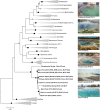Single-Cell-Genomics-Facilitated Read Binning of Candidate Phylum EM19 Genomes from Geothermal Spring Metagenomes
- PMID: 26637598
- PMCID: PMC4751853
- DOI: 10.1128/AEM.03140-15
Single-Cell-Genomics-Facilitated Read Binning of Candidate Phylum EM19 Genomes from Geothermal Spring Metagenomes
Abstract
The vast majority of microbial life remains uncatalogued due to the inability to cultivate these organisms in the laboratory. This "microbial dark matter" represents a substantial portion of the tree of life and of the populations that contribute to chemical cycling in many ecosystems. In this work, we leveraged an existing single-cell genomic data set representing the candidate bacterial phylum "Calescamantes" (EM19) to calibrate machine learning algorithms and define metagenomic bins directly from pyrosequencing reads derived from Great Boiling Spring in the U.S. Great Basin. Compared to other assembly-based methods, taxonomic binning with a read-based machine learning approach yielded final assemblies with the highest predicted genome completeness of any method tested. Read-first binning subsequently was used to extract Calescamantes bins from all metagenomes with abundant Calescamantes populations, including metagenomes from Octopus Spring and Bison Pool in Yellowstone National Park and Gongxiaoshe Spring in Yunnan Province, China. Metabolic reconstruction suggests that Calescamantes are heterotrophic, facultative anaerobes, which can utilize oxidized nitrogen sources as terminal electron acceptors for respiration in the absence of oxygen and use proteins as their primary carbon source. Despite their phylogenetic divergence, the geographically separate Calescamantes populations were highly similar in their predicted metabolic capabilities and core gene content, respiring O2, or oxidized nitrogen species for energy conservation in distant but chemically similar hot springs.
Copyright © 2016, American Society for Microbiology. All Rights Reserved.
Figures




References
-
- Rinke C, Schwientek P, Sczyrba A, Ivanova NN, Anderson IJ, Cheng JF, Darling A, Malfatti S, Swan BK, Gies EA, Dodsworth JA, Hedlund BP, Tsiamis G, Sievert SM, Liu WT, Eisen JA, Hallam SJ, Kyrpides NC, Stepanauskas R, Rubin EM, Hugenholtz P, Woyke T. 2013. Insights into the phylogeny and coding potential of microbial dark matter. Nature 499:431–437. doi:10.1038/nature12352. - DOI - PubMed
Publication types
MeSH terms
LinkOut - more resources
Full Text Sources

